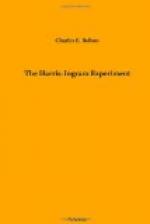CHAPTER XXIV
THE MAGIC BAND OF BEATEN GOLD
The demonetization of silver by the government in 1873, and its great production, had reduced the value of the white metal one-half, so young Harris resolved to seek for gold, and began a search, which proved to be a most romantic success.
At first he hesitated to leave Montana, as its quartz veins and sluice boxes in twenty-five years had poured out $400,000,000, and its mineral resources were yet almost wholly unknown. The area of this single mountainous state could not be blanketed by the six New England States, and New York, or covered by England, Wales, Ireland, and Scotland combined.
Finally Alfonso determined to follow the great mineral belt in a southwesterly direction even to the Sierra Nevada Range if need be. At Livingston he went south by railway through a gateway of the mountains, and up the fertile Paradise Valley, following the cool green waters of the Yellowstone alive with trout and equally gamesome graylings.
At Cinnabar Alfonso joined a merry party of tourists, who mounted a Concord coach, and the four grays were urged to a brisk pace over a smooth government road towards the great National Park. How exhilarating this six miles’ ride, and how imposing the scenery, as the coach enters this Geologist’s Paradise!
The Yellowstone or National Park contains 2,288,000 acres, and is fifty times the size of France’s greatest park at Fontainebleau. Its altitude is a half mile higher than the summit of Mt. Washington, and the whole park is encircled by snow-clad peaks and majestic domes from three to five thousand feet high. This reservation by Congress in 1872, of 3575 square miles of public domain in perpetuity for the pleasure of the people, was a most creditable act.
Alfonso found that the park abounded in wild gorges, grand canyons, dancing cascades, majestic falls and mountains, picturesque lakes, curious hot springs, and awe-inspiring geysers. He and his party pushed through the Golden Gate, marveled at the wonders of the Norris and Firehole Basins, stood entranced before the mighty Canyon then bathed in the transparent Yellowstone Lake, and by nine o’clock were lulled to sleep in the shade of fragrant pines.
After breakfast next morning, while Alfonso and the hotel guests sat on the porch, a retired army captain, who had served in the Seventh U.S. Cavalry, said he wished a party could be organized to visit General Custer’s monument east of the National Park on the Little Big Horn River. There the Government had marked the historic battleground, where on the morning of the 24th of June, 1876, two hundred of the famous Seventh Cavalry and their brave leader, were overwhelmed and slaughtered by 2,500 Indians under the famous chief, Sitting Bull. Custer was tall and slender, with blue eyes and long light hair. He had fought at Bull Run and Gettysburg, and was present at Lee’s surrender at Appomattox. He was promoted to brigadier general when he was twenty-three years old, and became major general when he was twenty-five. Eleven horses were shot under him. Once he saved the flag by tearing it from its staff and concealing it in his bosom. What Napoleon said of Ney is also true of Custer, “He was the bravest of the brave.”




